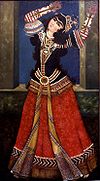| Part of a series on the |
| Culture of Iran |
|---|
 |
|
|
The majority of the population of Iran (approximately 80%) consists of Iranic peoples.[1][2] The largest groups in this category include Persians (who form between 60-65% of the Iranian population) and Kurds, with smaller communities including Gilakis, Mazandaranis, Lurs, Tats, Talysh, and Baloch.
Turkic peoples constitute a substantial minority of about 15–24%, the largest group being the Azerbaijani. They are the second largest ethnicity in Iran. Other Turkic groups include the Turkmen, Qashqai and Kazakhs peoples.
Arabs account for about 1-2% of the Iranian population. The remainder, amounting to about 1% of Iranian population, consists of a variety of minor groups, mainly comprising Assyrians, Armenians, Georgians, Circassians,[3] and Mandaeans.[4]
At the beginning of the 20th century, Iran had a total population of just below 10 million, with an approximate ethnic composition of: 6 million Persians (60%), 2.5 million Azeris (25%), 0.2 million Mazandaranis and Gilakis each (2% each).[5]
Due to its highly ethnically-heterogeneous population, Iran lacks a titular ethnic group and enjoys a cultural and linguistic diversity which has been unified under a single national identity based on the standard Persian language and culture (Zana).[6]
- ^ "Iran" in Encyclopedia of Islam, Leiden. C.E. Bosworth (editor): Persians (65 percent), Azeri Turks (16 percent), Kurds (7 percent), Lurs (6 percent), Arabs (2 percent), Baluchis (2 percent), Turkmens (1 percent), Turkish tribal groups such as the Qashqai (1 percent), and non-Persian, non-Turkic groups such as Armenians, Assyrians, and Georgians (less than 1 percent). Library of Congress, Library of Congress – Federal Research Division. "Ethnic Groups and Languages of Iran" (PDF). Library of Congress. Retrieved 2 December 2009.
- ^ According to the CIA World Factbook, the ethnic breakdown of Iran is as follows: Persian 61%, Azeri 16%, Kurd 10%, Lur 6%, Baloch 2%, Arab 2%, Turkmen and Turkic tribes 2%, other 1%. "The World Factbook – Iran". Retrieved 21 April 2008.
- ^ Carl Waldman, Catherine Mason, Encyclopedia of European Peoples, pp.175
- ^ Russell Contrera (8 August 2009). "Saving the people, killing the faith – News – Holland Sentinel – Holland, MI". Holland Sentinel. Archived from the original on 6 March 2012. Retrieved 21 September 2015.
- ^ Ervand Abrahimian, "A History of Modern Iran", Cambridge University Press, 2008. p. 18: "Communal Composition of Iran, 1900 Persian 6 million Azeris 2.5 million Mazandaranis 200,000 Gilakis 200,000 Taleshis 20,000 Tatis 20,000"
- ^ Iran: A Modern History, Abbas Amanat